
Essen is the central and, after Dortmund, second-largest city of the Ruhr, the largest urban area in Germany. Its population of 586,608 makes it the fourth-largest city of North Rhine-Westphalia after Cologne, Düsseldorf and Dortmund, as well as the tenth-largest city of Germany. Essen lies in the larger Rhine-Ruhr metropolitan region, second largest by GDP in the EU, and is part of the cultural area of Rhineland. Because of its central location in the Ruhr, Essen is often regarded as the Ruhr's "secret capital". Two rivers flow through the city: the Emscher in the north, and in the south the Ruhr River, which is dammed in Essen to form the Lake Baldeney and Lake Kettwig reservoirs. The central and northern boroughs of Essen historically belong to the Low German Westphalian dialects area, and the south of the city to the Low Franconian Bergish area.

Cosmas and Damian were two Arab physicians and early Christian martyrs. They practised their profession in the seaport of Aegeae, then in the Roman province of Cilicia.
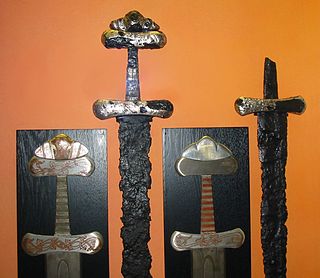
The Viking Age sword or Carolingian sword is the type of sword prevalent in Western and Northern Europe during the Early Middle Ages.
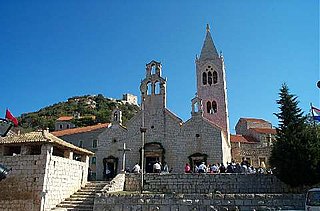
The Church of Saints Cosmas and Damian is a Roman Catholic church on Lastovo Island off the coast of Croatia.
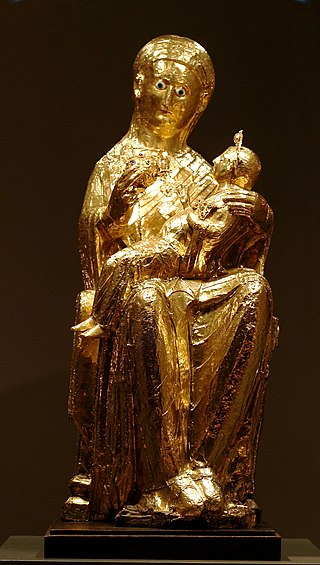
The Golden Madonna of Essen is a sculpture of the Virgin Mary and the infant Jesus. It is a wooden core covered with sheets of thin gold leaf. The piece is part of the treasury of Essen Cathedral, formerly the church of Essen Abbey, in North Rhine-Westphalia, Germany, and is kept on display at the cathedral.

Essen Abbey was a community of secular canonesses for women of high nobility that formed the nucleus of modern-day Essen, Germany.

The Imperial Sword is one of the four most important parts of the Imperial Regalia (Reichskleinodien) of the Holy Roman Empire. During a coronation, it was given to the emperor along with the Imperial Crown (Reichskrone), Imperial Sceptre (Reichszepter), and the Imperial Orb (Reichsapfel). All four parts of the Imperial Regalia are displayed in the Imperial Treasury at the Hofburg Palace in Vienna, Austria. It is also known as Mauritiusschwert, or the sword of Saint Maurice.

Gandersheim Abbey is a former house of secular canonesses (Frauenstift) in the present town of Bad Gandersheim in Lower Saxony, Germany. It was founded in 852 by Count Liudolf of Saxony and his wife, Oda, progenitors of the Liudolfing or Ottonian dynasty, whose rich endowments ensured its stability and prosperity.
Saint Altfrid was a leading figure in Germany in the ninth century. A Benedictine monk, he became Bishop of Hildesheim, and founded Essen Abbey. He was also a close adviser to the East Frankish King Louis the German.

Essen Minster, since 1958 also Essen Cathedral is the seat of the Roman Catholic Bishop of Essen, the "Diocese of the Ruhr", founded in 1958. The church, dedicated to Saints Cosmas and Damian and the Blessed Virgin Mary, stands on the Burgplatz in the centre of the city of Essen, Germany.

The Cross of Lothair or Lothair Cross is a crux gemmata processional cross dating from about 1000 AD, though its base dates from the 14th century. It was made in Germany, probably at Cologne. It is an outstanding example of medieval goldsmith's work, and "an important monument of imperial ideology", forming part of the Aachen Cathedral Treasury, which includes several other masterpieces of sacral Ottonian art. The measurements of the original portion are 50 cm height, 38.5 cm width, 2.3 cm depth.
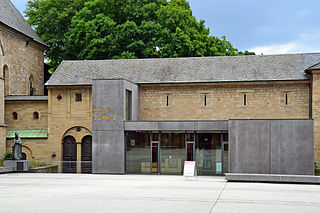
The Essen Cathedral Treasury is one of the most significant collections of religious artworks in Germany. A great number of items of treasure are accessible to the public in the treasury chamber of Essen Minster. The cathedral chapter manages the treasury chamber, not as a museum as in some places, but as the place in which liturgical implements and objects are kept, which continued to be used to this day in the service of God, so far as their conservation requirements allow.

The Cross of Otto and Mathilde, Otto-Mathilda Cross, or First Cross of Mathilde is a medieval crux gemmata processional cross in the Essen Cathedral Treasury. It was created in the late tenth century and was used on high holidays until recently. It is named after the two persons who appear on the enamel plaque below Christ: Otto I, Duke of Swabia and Bavaria and his sister, Mathilde, the abbess of the Essen Abbey. They were grandchildren of the emperor Otto I and favourites of their uncle, Otto II. The cross is one of the items which demonstrate the very close relationship between the Liudolfing royal house and Essen Abbey. Mathilde became Abbess of Essen in 973 and her brother died in 982, so the cross is assumed to have been made between those dates, or a year or two later if it had a memorial function for Otto. Like other objects in Essen made under the patronage of Mathilde, the location of the goldsmith's workshop is uncertain, but as well as Essen itself, Cologne has often been suggested, and the enamel plaque may have been made separately in Trier.

Mathilde was Abbess of Essen Abbey from 973 to her death. She was one of the most important abbesses in the history of Essen. She was responsible for the abbey, for its buildings, its precious relics, liturgical vessels and manuscripts, its political contacts, and for commissioning translations and overseeing education. In the unreliable list of Essen Abbesses from 1672, she is listed as the second Abbess Mathilde and as a result, she is sometimes called "Mathilde II" to distinguish her from the earlier abbess of the same name, who is meant to have governed Essen Abbey from 907 to 910 but whose existence is disputed.

The Cross of Mathilde is an Ottonian processional cross in the crux gemmata style which has been in Essen in Germany since it was made in the 11th century. It is named after Abbess Mathilde who is depicted as the donor on a cloisonné enamel plaque on the cross's stem. It was made between about 1000, when Mathilde was abbess, and 1058, when Abbess Theophanu died; both were princesses of the Ottonian dynasty. It may have been completed in stages, and the corpus, the body of the crucified Christ, may be a still later replacement. The cross, which is also called the "second cross of Mathilde", forms part of a group along with the Cross of Otto and Mathilde or "first cross of Mathilde" from late in the preceding century, a third cross, sometimes called the Senkschmelz Cross, and the Cross of Theophanu from her period as abbess. All were made for Essen Abbey, now Essen Cathedral, and are kept in Essen Cathedral Treasury, where this cross is inventory number 4.

The Cross with large enamels, or Senkschmelz Cross, known in German as the Senkschmelzen-Kreuz or the Kreuz mit den großen Senkschmelzen, is a processional cross in the Essen Cathedral Treasury which was created under Mathilde, Abbess of Essen. The name refers to its principal decorations, five unusually large enamel plaques made using the senkschmelz technique, a form of cloisonné which looks forward to champlevé enamel, with a recessed area in enamel surrounded by a plain gold background, and distinguishes it from three other crosses of the crux gemmata type at Essen. The cross is considered one of the masterpieces of Ottonian goldsmithing.
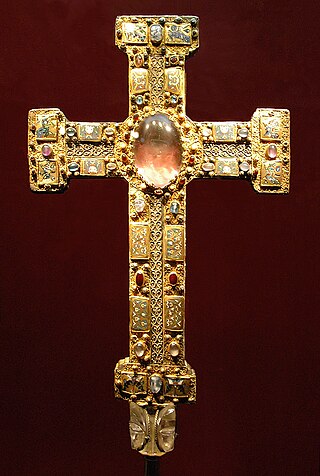
The Cross of Theophanu is one of four Ottonian processional crosses in the Essen Cathedral Treasury and is among the most significant pieces of goldwork from that period. It was donated by Theophanu, Abbess of Essen, who reigned from 1039 to 1058.

The Essen Crown is an Ottonian golden crown in the Essen Cathedral Treasury. It was formerly claimed that it might have been the crown with which the three-year-old Otto III was crowned King of the Romans in 983, which is the source of its common name, the Childhood Crown of Otto III. However, this idea most probably derives from the wishful thinking of early twentieth century historians of Essen and it is now widely rejected. However it is certainly the oldest surviving lily crown in the world.
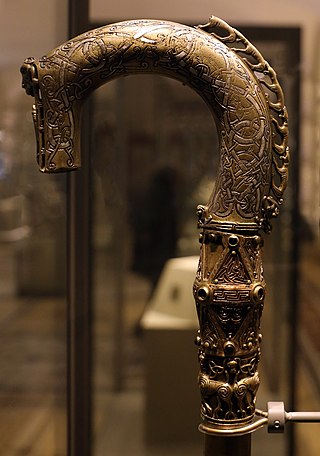
An Insular crozier is a type of processional bishop's staff (crozier) produced in Ireland and Scotland between 800 and 1200. Such items can be distinguished from mainland European types by their curved and open crooks, and drop. By the end of the 12th century, production of Irish croziers had largely ended, but examples continued to be reworked and added to throughout the Romanesque and Gothic periods. Although many of the croziers are associated with 5th- and 6th-century saints, the objects were not made until long after the saints had died. A majority originate from around the 9th century, with a number further embellished between the 11th and 13th centuries.

The Seven-Branched Candelabrum is a large candlestand from the Essen Cathedral Treasury. Today, it stands on the ground floor of the Westwork of Essen Cathedral. The lampstand, which dates to around the year 1000, is a significant bronze artwork of the early Middle Ages and the oldest preserved seven-armed church candelabrum.



















